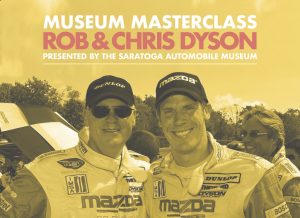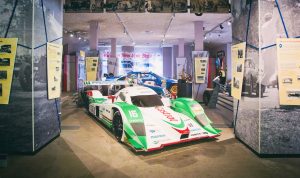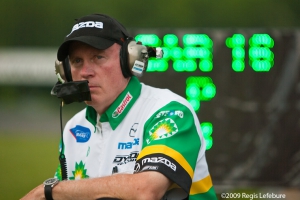By 1994, the GTP era ended and IMSA created the World Sports Car series, which marked a new beginning for Dyson with a switch to open-top, flat-bottomed prototypes. But Rob`s first choice in a produced-based Ferrari-engined Spice chassis wasn`t necessarily the winning recipe, as he explains.
“I looked at the rules and they wanted street-derived engines so I pulled out an issue of Road & Track,” Rob Dyson recalls. “They had a winter rundown of the major specs of every car they tested that year. I looked down to see what kind of engines these street cars had. I went down the list and saw the 348 Ferrari had a 3.5-liter V8, twin cam.
“I thought that might be a good thing, so I had one of the guys get a couple of junk engines… and we put it in a Spice chassis. But little did I know that Spice was literally going out of business. When we got the car from them, it was not very well built. We had to go completely through it and fix all of the problems. It was just a disaster.”
Dyson sought engineering advise from Bob Riley and met with the renowned chassis constructor at his shop in Indianapolis. One thing led to another and Dyson helped commission the build of the Riley & Scott MkIII for 1995, an all-new, state-of-the-art prototype. Dyson also made the switch to Lozano Brothers-tuned big-block Ford V8s.
“We picked [the car] up in Daytona,” Rob Dyson says. “I got in the car and set it up according to Bob`s specs and pulled out of the pits. As soon as I went onto the banking, I said, `Boy, this car really feels great.` I came out of the Bus Stop, and wasn`t even going full blast, but I knew it was really strong. I knew we had a winning combination. Even though the Ferraris were there and there were several other variants.”
The 1995 season brought immediate success for the new Riley & Scott-Ford package, with five wins, nine consecutive podiums and a 1-2 finish on the streets of New Orleans. However, Weaver lost the championship by a mere two points, with a strategy call early in the season having a likely affect on the title outcome.
“We were in Halifax and had trouble in practice,” Weaver explains. “And in the race, for some reason, the fuel filter went in backward, so we had fuel system trouble in the race and dropped back.
We had two cars there and I had the option to sit out and get in to whichever car [was higher placed] but I thought it was unfair as the others only had one car… If I would have just sat it out [and got in the No. 20], we would have won the championship.”
The team also had a love-hate relationship with the most prestigious race each season, the Rolex 24 at Daytona. While having scored five poles, Dyson and co. walked away with only two wins in the twice-around-the-clock endurance classic, after often having the car to beat.
“We should have won Daytona at least five times,” Rob Dyson says. “We had strong cars, leading extensive periods of time during the event, with extensive leads and didn`t win it. We finally won it in `97 and again in `99.
“In 1998, we had a 1-2 going and my co-driver in the car that I was driving with James crashed into the slowest car on the racetrack. Butch [Leitzinger] and Andy [Wallace] and Elliott [Forbes-Robinson] were running the other car and the engine let loose with an hour and a half to go.
“We had a substantial lead in the [main] car. That was really a sad deal. That was probably one of the Daytona`s that really hurt.”
Through the adversity, the team always bounced back. On the heels of its second Daytona win, Elliott Forbes-Robinson earned the driver`s championship in the inaugural year of the American Le Mans Series, despite not winning a single ALMS round all season.
What`s more is that it came in the trusty Riley & Scott, an aging car when compared to the then cutting-edge BMW V12 LMR and Panoz LMP1s. EFR`s title chase came right down to the wire in the season finale at Las Vegas Motor Speedway.
“It was complete crunch time and was probably the most pressure-cooked weekends we`ve ever had as a team,” Chris Dyson recalls. “We came into the last race of the year with a shot to win it… So there was a lot of pressure on everyone. James started fifth or sixth and by the second lap he was third.
“I`ll never forget it. I went out to the infield and stood right on the post. Just watching the variety and the excitement of the cars. We were right back to IMSA in the `80s when I was standing on that sideline and there were six or seven different cars, all pro drivers, going for the win.
“I just remember the euphoria that we felt when we won that championship. For the team, it was a huge underlining of where we were at that point. And to win a prestigious championship, it was a huge boost.”
Having juggled a dual-series program, which saw Weaver claim back-to-back Grand-Am titles and Chris Dyson making his professional driving debut, the team shifted its focus entirely to the ALMS by 2003, but with a new weapon of choice. After eight years with Riley & Scott, the move was made to AER-powered Lolas, first with the LMP675-class MG Lola EX257.
The “baby” prototype not only took Chris Dyson to his first driver`s championship in 2003, but also netted a historic overall victory at Sonoma Raceway, while up against the mights of the factory Audis.
“The MG victory was memorable because that was the first time a LMP2 car beat a LMP1 car,” says Weaver, who shared the winning car with Butch Leitzinger. “That was a fantastic weekend.
“In the morning warm-up, we went around one-second a lap quicker than everyone else, but for some reason it didn`t appear on the time sheets. We thought this was fantastic and nobody was going to know that we were really going to be on the pace.
“Butch started and the track started to break up a bit. The Michelin tires were gaining a lot of pickup and the Goodyears didn`t. So by the end of the race, the Audis were just dead in the water and we managed to drive straight past them.”
A step up to LMP1 the following year, with heavily developed MG Lolas, saw Weaver and Leitzinger place second in the championship, prior to a switch to an all-new Lola B06/10 AER package for 2006. However, Dyson`s radical move to customer Porsche RS Spyders the following year ended up being one of the most debated decisions in the team`s history. While returning to their roots with the German manufacturer, the relationship with the factory, and a turn-key prototype needing little development, put the Dyson`s in a unique situation they had not faced before.
“Do I regret it? In some respects I do because we had the Lola with the twin-turbo V8 that we were working on and we in essence abandoned that project to go to the Porsche project,” Rob Dyson says on the decision to race Porsche RS Spyders in 2007-08. “I wish it had gone better for us and for them. But I think it was great racing; the cars were absolutely impeccable. It took too much out of our control, and in those days we weren`t prepared to do that. I think that was where the rub was.”
When one door closed, another one opened, as Dyson reunited with the folks at Lola and AER to field Mazda`s factory-backed prototype effort in 2009. It brought returned success, including the first overall win for Mazda in ALMS competition the following year and the P1 title in 2011.
“Ironically, while we were working with the Spyder program, I had been seeing John Doonan was having difficulties with the Mazda cars,” Rob Dyson adds. “One thing led to another and off we went with them. That was a great package and it`s been an absolutely great relationship.”
The partnership with Mazda has continued to this day, with the team`s fourth generation Lola-AER prototype package debuting in 2012 in the hands of Chris Dyson and Guy Smith. The duo recorded a monumental victory at Road America that year, which still stands as the closest finish in ALMS history.
Through the years, Dyson Racing has stood out as one of the most accomplished privateer squads in the business. According to Weaver, it`s because of the man at the top, who started it all 30 years ago.
“It`s Rob`s team. If you`ve got one person in charge who has good leadership skills, it`s very hard to go wrong,” Weaver says. “You`ve got the leadership and resources to back it up. It`s one guy [to ask], `Right, Governor, what are we doing?` It`s that easy.
“If you were driving for a big manufacturer, there`s layer upon layer of management. The PR side wants this and the management side wants this and the sponsor wants something else. It does make it a lot harder. There are a lot of advantages driving for a good privateer.”
What does the future hold for Rob, Chris and the family run operation? The unification between Grand-Am and the ALMS has no doubt changed the sports car racing landscape, but that`s nothing new for the team, which has been through the rise, fall and resurrection of the IMSA empire. In fact, with its long-term vision for the greater good of the sport, it wouldn`t surprise many to see Dyson Racing continue its winning legacy for another 30 years, on whatever path U.S. sports car racing takes.
“We`ve changed cars a lot over the years; configurations have changed over the years,” Rob Dyson notes. “When I look back on it, I think we1ve had to take the opportunities as they come and change has been a constant, really.
“Looking forward, we`ll have to see how the rule book comes out and see how they handle the competition. I honestly believe they`re trying to make it work. Give it a little bit of time and effort, and everyone giving a little, it will work.
“Everybody understands the opportunity we have on a unified series to put all of the road racing guys together. I`m hopeful that it works.”


